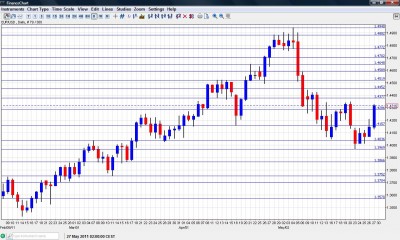The Euro managed to stabilize and retrace some of its falls, as the Greek crisis continues. How long will it last? The upcoming week consists of key inflation and employment indicators – keys to the rate decision. Here’s an outlook for the upcoming events and an updated technical analysis for EUR/USD.
At least 7 new signs appeared, hinting that a Greek default is quite close. As we turn the page on May, it’s clear that June will be decisive. And what will Trichet say about the rates? The keys are in inflation numbers. Let’s start:
EUR/USD daily chart with support and resistance lines marked. Click to enlarge:
- German Retail Sales: Publication time unknown at the moment. Europe’s largest country has seen a disappointing fall in the volume of sales last month. They fell for a second time in a row, this time sharply: 2.1%. A big rise is likely now.
- French Consumer Spending: Tuesday, 6:45. Europe’s second largest country also saw a drop in consumer activity: spending fell unexpectedly by 0.7%, falling short of an expected rise. A modest rise is expected.
- German Unemployment Change: Tuesday, 7:55. The drop in unemployment has been very impressing in Germany, especially as many European countries suffer from high unemployment rates. The last three months have been outstanding, with drops of 54K, 55K and 37K. A drop of around 20K is likely now. This will also be positive for the Euro.
- CPI Flash Estimate: Tuesday, 9:00. This may be the key to the rate decision in the following week. Headline consumer price index has risen to an annual level of 2.8%, significantly above target. But since the last call, commodity prices have fallen sharply. As there’s a big gap between Core CPI which is OK and headline CPI, the fall in commodity prices can push inflation lower, and can trigger not only another pause, but another pause in saying “strong vigilance”, pushing the rate hike further back.
- Unemployment Rate: Tuesday, 9:00. This is the big weight on Europe: Spain has an unemployment rate of 21.3%, and there are too many countries with rates above 10%. Germany’s unemployment rate is only 7.1% – the average number is 9.9%, and this will likely remain unchanged. Note that the CPI release overshadows this one.
- Manufacturing PMI: Wednesday, 8:00. The initial flash estimate was disappointing, only 54.8 points, mostly due to German weakness. This will likely be confirmed now.
- Services PMI: Friday, 8:00. Also in the services sectors, a slowdown was seen, at least according to the first release. The score of 55.4 is predicted to be confirmed in the final call.
* All times are GMT.
EUR/USD Technical Analysis
Euro/Dollar had a rough start to the week, falling below 1.40. It later recovered nicely and gradually climbed in range, breaking above the 1.4160 line (discussed last week).
Technical levels, from top to bottom:
Hi in the sky, 1.4882 has been a distinct cap. Below – 1.4775 was the support line of the tight range trading. 1.47 is a rather minor line, that only temporarily capped the pair on its way up.
1.4650 was a peak on the way up, and then switched to significant support. It is a rather far as well 1.4580 was a line of resistance in the short stabilization period in the past week, and also in mid-April, and is a strong line of resistance now.
1.4520 was the bottom border of that range and an even stronger line, as it already worked as tough resistance a few weeks ago. Minor resistance is at 1.4450, which was an important line in the past, and had different roles beforehand.
1.4375 provided support a few weeks ago, and held the pair for a short period of time before the final fall. It returns to having a major role, as it is getting closer. The peak of November 2010 at 1.4282 managed to temporarily cap the pair’s rise, but it is a weak line.
1.4160 was a swing high in the past, and also a swing low a few weeks ago, before the big surge to higher levels. It was shattered in the past weeks and remains a pivotal line now. Just above the round number of 1.40, we find very important support at 1.4030 – this is a very distinctive line, as seen in the graph.
Lower, 1.3950 was a pivotal line when the pair traded in lower ranges and proved that it is of high importance. The fall of the pair stopped short of reaching this line just now. Another significant support line is at 1.3860, which worked in both directions earlier this year.
1.3570 worked as support at the beginning of the year, and will have the same role if the Euro falls that far. The last important line is 1.3440, that is very distinctive. It was a clear border between ranges, more than once in recent years. A break below will be a very bearish sign.
I remain bearish on EUR/USD.
Here are some recommended reads for the pair:
- FX Tech Strategy sees the Euro resuming the long term uptrend moves.
- Simon Smith watches as Europe is getting tougher with Greece.
- Sophia Smith provides an interesting technical analysis and trading opportunities.
- Kathy Lien dismisses the recent rally and sees sovereign debt troubles still plaguing the currency.
- Dean Popplewell says: buy the euro high, sell higher.
- Andriy Moraru provides weekly support and resistance lines for major pairs, including EUR/USD.
Further reading:
- For a broad view of all the week’s major events worldwide, read the USD outlook.
- For the Japanese yen, read the USD/JPY forecast.
- For GBP/USD (cable), look into the British Pound forecast.
- For the Australian dollar (Aussie), check out the AUD to USD forecast.
- For the New Zealand dollar (kiwi), read the NZD forecast.
- For USD/CAD (loonie), check out the Canadian dollar
- For the Swiss Franc, see the USD/CHF forecast.

